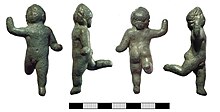Waltham St Lawrence
| Waltham St Lawrence | |
|---|---|
| Village | |
 Neville Hall and the Bell Inn | |
Location within Berkshire | |
| Population | 1,232 (2001) 1,215 (2011 Census)[1] |
| OS grid reference | SU8276 |
| Civil parish |
|
| Unitary authority | |
| Ceremonial county | |
| Region | |
| Country | England |
| Sovereign state | United Kingdom |
| Post town | Reading |
| Postcode district | RG10 |
| Dialling code | 0118 |
| Police | Thames Valley |
| Fire | Royal Berkshire |
| Ambulance | South Central |
| UK Parliament | |
Waltham St Lawrence is a village and
Toponymy
The name 'Waltham' is believed to be derived from the
History

There is evidence of the existence of a
Until quite recent times a large lake separated Waltham St. Lawrence from Ruscombe (the name 'Stanlake' would seem to be a survival of this) and so the southern end of the parish was known as South Lake. The
"September 17th, 1667,
King Charles 2nd, with his brother James Duke of Yorke, Prince Rupert Duke of Cumberland, James Duke of Monmouth and many more of the nobles dined at Bellingbear House in the great Parlour".[4]
At that time,
In 1920 Hal Taylor founded The Golden Cockerel Press, privately printing books from a surplus army hut he had erected in the village. The press continued to operate there under the later ownership of Robert Gibbings until, in 1933, economic circumstances forced its sale and production was relocated to London.[6]
Location and amenities
Waltham St Lawrence is located in a rural setting in East
Transport
The nearest rail stations are at Twyford 4 mi (6.4 km), Maidenhead 5 mi (8.0 km), Wokingham 6 mi (9.7 km) and Bracknell 7 mi (11 km). There is a local bus service to Maidenhead and Bracknell.
Parish church
Architecture

The parish church of
The
Bells

At the west end of the church is a square embattled tower, with a small turret at the south-west angle containing a staircase leading to the belfry and the top of the tower. The ringing chamber is open to the church and contains a beautiful window which is the only good glass in the building. This window, and the square-headed doorway below it, is of the Perpendicular period in English architecture. The tower was built in two sections. The lower part dates from the 14th century and the upper from the 16th. Some of the bells date back to the time of Charles II, but the peal only from 1808, when the bells were recast and rehung.
The
Registers
The parish registers its date from 25 November 1558. The originals are lodged for safekeeping with the county archivist in Reading, but the parish priest possesses a transcript (1558 to 1812) by Edmund Newbery. Apart from the usual entries of births, marriages and deaths, there are interesting memoranda, such as the following:
"Memorandum that the yewe tree at the churchyard gate on the right hand as one goeth into the churchyard up to the churchpond was planted by Thos. Wilkinson vicar of Waltham in February 1655"[4]
"Mabel modwyn widowe abact 68 years old arraigned for witch craft at Redding 29th Feb: and condemned on the 5th of March, 1655. Shee lived at ye south-wist cornr. of lower Innings in ye cornr. next to Binfield".[4]
Notable people
- Shanghai Municipal Council
- Robert Gibbings, wood engraver, author, broadcaster, educator and publisher. Proprietor of the Golden Cockerel Press.
- Henry Neville (died 1615), English courtier, politician, diplomat, candidate for the authorship of Shakespeare's works.
- John Newbery, publisher
- Ernest Renshaw, former tennis player, died in the village.
Film and television
In the 1990s
References
- ^ "Civil Parish population 2011". Neighbourhood Statistics. Office for National Statistics. Retrieved 1 December 2016.
- ^ "Mills, A. D., 2011, A Dictionary of British Place Names".
- ^ Broomfield, Margaret (11 August 2016) [31 March 2016]. "Finds record for: SUR-CE0231". The Portable Antiquities Scheme. Retrieved 14 September 2023.
- ^ a b c Waltham St Lawrence Parish Registers
- ^ "Waltham St Lawrence". BBC Domesday Reloaded.
- ISBN 1-58456-093-2OCLC 50478453.
- ^ "Welcome to The Shurlock Inn".
- ^ Historic England. "Church of St Lawrence (1117515)". National Heritage List for England. Retrieved 21 March 2020.
External links
 Media related to Waltham St Lawrence at Wikimedia Commons
Media related to Waltham St Lawrence at Wikimedia Commons- Waltham St Lawrence Parish website

